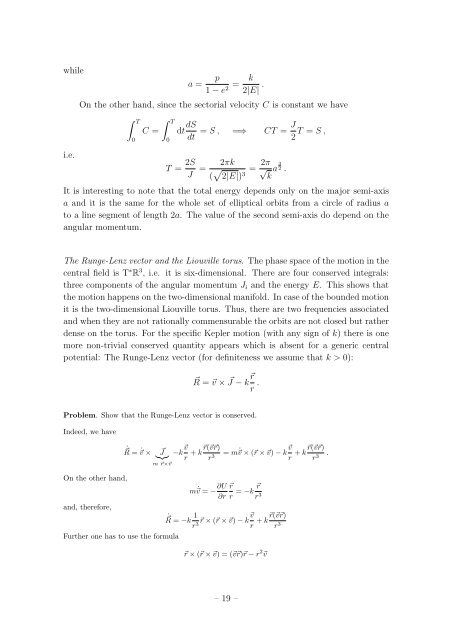Student Seminar: Classical and Quantum Integrable Systems
Student Seminar: Classical and Quantum Integrable Systems
Student Seminar: Classical and Quantum Integrable Systems
Create successful ePaper yourself
Turn your PDF publications into a flip-book with our unique Google optimized e-Paper software.
while<br />
i.e.<br />
a =<br />
p<br />
1 − e = k<br />
2 2|E| .<br />
On the other h<strong>and</strong>, since the sectorial velocity C is constant we have<br />
∫ T<br />
0<br />
C =<br />
∫ T<br />
0<br />
dt dS<br />
dt = S , =⇒ CT = J 2 T = S ,<br />
T = 2S J =<br />
2πk<br />
( √ 2|E|) = √ 2π a 3 2 .<br />
3 k<br />
It is interesting to note that the total energy depends only on the major semi-axis<br />
a <strong>and</strong> it is the same for the whole set of elliptical orbits from a circle of radius a<br />
to a line segment of length 2a. The value of the second semi-axis do depend on the<br />
angular momentum.<br />
The Runge-Lenz vector <strong>and</strong> the Liouville torus. The phase space of the motion in the<br />
central field is T ∗ R 3 , i.e. it is six-dimensional. There are four conserved integrals:<br />
three components of the angular momentum J i <strong>and</strong> the energy E. This shows that<br />
the motion happens on the two-dimensional manifold. In case of the bounded motion<br />
it is the two-dimensional Liouville torus. Thus, there are two frequencies associated<br />
<strong>and</strong> when they are not rationally commensurable the orbits are not closed but rather<br />
dense on the torus. For the specific Kepler motion (with any sign of k) there is one<br />
more non-trivial conserved quantity appears which is absent for a generic central<br />
potential: The Runge-Lenz vector (for definiteness we assume that k > 0):<br />
⃗R = ⃗v × ⃗ J − k ⃗r r .<br />
Problem. Show that the Runge-Lenz vector is conserved.<br />
Indeed, we have<br />
˙⃗R = ˙⃗v ×<br />
}{{}<br />
J ⃗ −k ⃗v r + k⃗r(⃗v⃗r) r 3<br />
m ⃗r×⃗v<br />
= m ˙⃗v × (⃗r × ⃗v) − k ⃗v r + k⃗r(⃗v⃗r) r 3 .<br />
On the other h<strong>and</strong>,<br />
m ˙⃗v = − ∂U ⃗r<br />
∂r r = −k ⃗r r 3<br />
<strong>and</strong>, therefore,<br />
˙⃗R = −k 1 r 3 ⃗r × (⃗r × ⃗v) − k⃗v r + k⃗r(⃗v⃗r) r 3<br />
Further one has to use the formula<br />
⃗r × (⃗r × ⃗v) = (⃗v⃗r)⃗r − r 2 ⃗v<br />
– 19 –

















